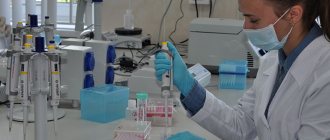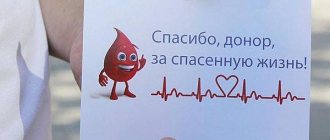5 / 5 ( 3 voices)
If we look at statistics, today almost 10% of fathers are raising other people’s children, and we are not talking about those cases where the stepfather knowingly adopted a child. And even if the father guesses that there is no relationship with the child, he does not always muster the courage to refute the fact of paternity. Although today there are plenty of ways to determine blood ties. One of these is the method of determining paternity by blood group. Often mothers themselves resort to it, who are not in a marital relationship with the child’s father and want to involve him in parental responsibilities. We will tell you about the effectiveness and methods of conducting various examinations.
Where to go
To establish paternity, the applicant must apply to the district or city court. The claim is filed at the place of residence of the defendant, with the exception of certain cases when the claim is filed by the mother:
- if the child has a disability group;
- if he is incapacitated.
If there is no opportunity to travel to another city, the plaintiff can send an application to the court by mail. The letter must be registered with a list of enclosed documentation.
The following may file a claim to establish blood relationship:
- mother of the child;
- the child himself after reaching adulthood;
- an authorized representative with a notarized power of attorney;
- government agencies involved in guardianship and trusteeship;
- father of the child.
It is important to note that if the initiator of the procedure for establishing consanguinity with a child is his putative father, then he must personally file the claim and participate in the proceedings. Legal representation is not used in this situation, since the woman may resort to deception to obtain financial gain.
Another important feature of the examination is the consent of the minor if he is over 10 years old. If there is no consent, the procedure will not be carried out.
If the results of the examination confirm the paternity of the participant in the proceedings, the court will make an appropriate decision. The parties will be given a 10-day period to appeal. After its expiration, participants can apply to the registry office with a court order to complete the necessary documentation. The certificate will be issued on the day of application.
How is the relationship established?
Each person's genetic information is unique and cannot be faked. Therefore, you can accurately identify your relatives by doing a DNA test to establish any relationship. In the laboratory, genetic studies are mainly carried out using particles of buccal epithelium, the collection of which is carried out on the inside of the cheek by smear. But DNA samples for research can also be isolated from other samples (hair, blood, nails, stains, cutlery, cigarette butts, etc.)
This procedure is absolutely safe and painless even for small children; it only takes a few minutes. After this, the material is examined in laboratory conditions - those loci that were transmitted from a relative along a specific line are compared.
Features of the technique
The test will require blood sampling from both parents and offspring. Next, depending on the chosen method, the composition of the collected material is studied.
Humans have 4 blood groups and 2 Rh factors. These blood parameters are set at the genetic level during the conception of the baby and remain unchanged until the end of life. Even procedures such as chemotherapy, blood transfusions, and bone marrow transplants cannot affect the blood type.
A child's blood counts will depend on the combination of his parents' genetic material. The resulting variations will not always be similar to the original sets of genes.
The determinant of the human blood group is the ABO gene, which has 3 forms: A, B, O. Due to the presence of a double set of chromosomes, the following combinations can occur: AA, BB, AO, AB, BO, OO.
Determining a child's blood type
So, medicine offers us several ways to determine paternity. We will tell you about their determination method and the accuracy of the results obtained.
Using the Rh factor
The simplest method of determining blood is to conduct an analysis to match the Rh factor. Despite the simplicity and accessibility of the method, it cannot be called universal. That is why, if the process of establishing paternity takes place in court, then the results of a blood test for the Rh factor are not accepted as 100% proof. In isolated cases, you can get a clear, indisputable answer using this method, when both parents have a negative Rh factor. Indeed, according to the biological characteristics of a person, a child inherits 100% negative Rh from his parents, if they both have it.
But with regards to the positive Rh factor, the situation here is different. If both parents have a positive blood test, then the probability of the child being related is 50%. What can we say about those cases when the Rh factors of the father and mother are completely different. Here, the probability of a relationship with a child cannot be determined, so in such situations the use of this method is practically not used.
If the father and mother have the same positive Rh factors, and the child has a negative one, this does not mean that he is not related.
DNA analysis
At the time of conception, the fetus receives genetic material from its parents, which is unique and inimitable. To collect DNA for analysis, various human biological materials are taken, which contain his genetic information - blood, saliva, hair, skin, natural secretions. Based on a thorough study, they are compared and the genetic chains match. There can be no mistakes, DNA testing is under the strict control of scientists, especially since the results obtained are double-checked - they must either be confirmed or refuted twice. This approach provides incredible accuracy, which so far cannot be compared with any other methods for conducting kinship.
DNA examination is the most accurate, almost one hundred percent confirmation of relationship. It is thanks to its high efficiency and reliable data that this method is the main evidence in court when the procedure for challenging paternity is underway. After all, a DNA test shows a 99.9% match in the genes of two people or denies the fact of blood ties. The main disadvantage of such a study is its high cost, about 15,000 rubles per test material. Accordingly, when establishing paternity you will have to pay a minimum of 30,000 rubles. In addition, if you want to get results in the near future - in 3 days, and not in 10 days, as expected, you will have to pay a lot more. But, despite the high cost of DNA analysis, it is carried out only in proven, highly professional medical institutions using expensive laboratory equipment.
ABO system
Another way to establish paternity is the AB0 system. Its essence is to compare the composition of blood for antigens. As we wrote earlier, depending on the blood group, the presence of a particular antigen can be recognized:
- for the first group – 00;
- for the second – A0, AA;
- for thirds – B0,BB;
- for the fourth AB.
This combination of a set of antigens is explained by the fact that each person has a double set of chromosomes, which is why we see such results. The calculation of the probability of a blood relationship is determined by comparing these indicators of both parents. And as a result, if the child is biological to this father, then he must have the same combination of antigens. This technique is more suitable for those parents who have the same blood type. And then, even if the result is correct depending on the set of chromosomes, it is not reliable, it may be a banal coincidence.
This method of determining kinship is not 100% proof of a blood connection between father and child, but can be used as a preliminary screening study.
Thus, the most accurate method of establishing a relationship between two people today remains DNA testing. Although the other two methods can show reliable information, it cannot be confirmed in any way. Therefore, if you are deciding the issue of establishing paternity through the court, then the data according to the determination of matches of the Rh factor and AB0 antigens can act as secondary evidence.
Disadvantages and advantages of the technique
The most important advantage of the method of identifying kinship using blood parameters is its low cost (compared to DNA testing). The price can range from 15 to 75 thousand rubles, which allows the examination to be carried out by a wide range of people.
Another important advantage is the almost 100 percent probability of no blood ties with a minor if the test shows negative results.
The method of identifying kinship based on blood parameters has a number of negative characteristics:
- the analysis cannot be carried out before the baby is born;
- the same blood counts between the father and the minor are not proof of consanguinity, they only indicate its probability;
- insufficient reliability;
- There are cases when an offspring has a blood type that does not match the parent’s. But this fact does not indicate the absence of a blood connection.
Why and how to identify relatives?
There are basic degrees of kinship ties - between parents and children, grandparents and grandchildren, brothers and sisters, etc. We found out how to establish the degree of relationship with maximum accuracy - undergo a genetic examination. When is such research necessary?
Most often it is used in the following cases:
- when dividing the inheritance among applicants;
- to prove or refute paternity;
- for the appointment of alimony in court;
- to determine membership in a particular ethnic group.
Today, DNK examination is the only objective and highly accurate way to confirm or refute blood relationships. This test can be done in a modern laboratory. Within the shortest possible time, you will receive an official result with accurate answers to the questions posed.
Variations of inheritance according to blood parameters
Using the table below, you can determine the blood type of the unborn child based on the blood types of the parents.
| Parents | Possible blood type of the offspring in shares | |||
| Blood type | I | II | III | IV |
| I,I | 1 | — | — | — |
| I,II | 0,50 | 0,50 | — | — |
| I,III | 0,50 | — | — | |
| I,IV | — | 0,50 | 0,50 | — |
| II,II | 0,25 | 0,75 | — | — |
| II,III | 0,25 | 0,25 | 0,25 | 0,25 |
| II,IV | — | 0,50 | 0,25 | 0,25 |
| III,III | 0,25 | — | 0,75 | — |
| III,IV | — | 0,25 | 0,50 | 0,25 |
| IV,IV | — | 0,25 | 0,25 | 0,50 |
As the data show, absolute indicators are determined only if the mother and father have blood type I. But this circumstance cannot guarantee a 100% result, since today you can find a huge number of carriers of this blood type.
Get tested at home
The right thing to do is to carry out the examination in specialized laboratories, in compliance with all strict standards for taking samples. However, today you can increasingly hear information that you can get tested at home. I would like to say right away that you will not be tested at home - this is a strict violation. But to collect material for the upcoming study at home, this happens in practice.
You do this not at your own discretion, but only after notifying the medical institution. In response, they can send an employee who will come and take a blood sample for future analysis and deliver it in special equipment to the laboratory. If you are conducting a DNA examination, where the biological material may be saliva, hair, dried stains of secretions, or a toothbrush, then you can take the sample yourself, but the organization that will conduct the examination will send you special envelopes, containers, tweezers and gloves, and then deliver it to the laboratory.
Before you agree to take tests at home, you must understand that the results obtained cannot be presented in court as primary evidence.
Heredity and Rh factor
Determining the Rh factor of an offspring is considered the simplest method for determining blood ties with the putative father. But this analysis also cannot be called reliable, since the offspring may have a negative Rh factor, while the mother and father are carriers of positive Rh. Absolute indicators can only be achieved if each parent is Rh negative. In such a situation, one should expect an offspring with the same blood parameters.
Using the table below, you can determine the Rh factor of the unborn child based on the parents’ indicators.
| Mother, Rh factor | Father, Rh factor | Possibility of a positive Rh factor in the offspring | Possibility of negative Rh factor in the offspring |
| + | + | 0,5 | 0,5 |
| + | — | 0,5 | 0,5 |
| — | + | 0,5 | 0,5 |
| — | — | 0 | 1 |
From the data presented it follows that in almost all cases (except the last one), the possibility of the fetus developing different Rhesus values is equal, therefore the use of this technique is inappropriate for identifying blood relationships between a man and a child.
Determine the degree of relationship using a DNA test
An accurate determination of the degree of relationship between people is carried out using a special test. Its results can accurately determine whether a genetic link exists between two or more people.
During the study, a comparison of identical DNA sections in the biomaterials of the tested subjects is carried out. The more matching sites are identified, the higher the likelihood of a biological connection. The test results make it possible to establish all degrees of genetic connection; in some cases, it is possible to establish ancestors up to the fourth or fifth generation.
ABO method
This method of studying blood parameters involves focusing on the presence (absence) of antibodies in the blood structure. Each group contains certain antibodies. Below is a table with probable forms according to the ABO classification.
| Mother, blood type | Father, blood type | |||
| I(O) | II(A) | III(B) | IV(AB) | |
| Probability of offspring's blood type | ||||
| I(O) | I(O) | II(B), I(O) | III(B), I(O) | II(A), III(B) |
| II(A) | II(A), I(O) | II(A), I(O) | II(A), III(B), IV(AB) | |
| III(B) | III(B), I(O) | III(B), I(O) | II(A), III(B), IV(AB) | |
| IV(AB) | II(A), III(B) | II(A), III(B), IV(AB) | II(A), III(B), IV(AB) | II(A), III(B), IV(AB) |
The data presented indicate that this technique is more reliable compared to a Rh blood test, but no one can give a 100% guarantee.
Negative results of the analysis
The method of identifying kinship based on blood indicators has one exceptional feature - with its help it is possible with almost 100% probability to refute the blood relationship between the baby and the alleged father.
That is, if, based on the results of the analysis, no relationship was found between the subjects being examined, then the parties do not need to spend money on a DNA test. The judge will make a decision based on the results of the analysis.
Disadvantages of determining paternity by blood group
We have already talked about the disadvantages of each method of determining paternity by analyzing blood samples. However, as a result, we will remind you about them once again so that you understand the responsibility of your actions:
- Neither the AB0 system nor the determination of the Rh factor gives any guarantee that the comparison of the blood type of the father and the child is reliable, even if they are completely identical, or vice versa.
- You can find out the results only after the birth of the child, in contrast to DNA examination, where the procedure for establishing kinship can be carried out after 5 months.
Despite the cheapness and accessibility of the procedure for establishing paternity by blood group, this method does not provide any guarantees about the reliability of the results, only in exceptional cases. If you decide to establish paternity, then trust a proven method - DNA testing, which allows you to accurately establish a blood connection between a child and the putative father. The high cost of the procedure fully justifies the results obtained and the outcome of the trial. Other methods based on blood tests can only serve as a preliminary result or additional evidence.










